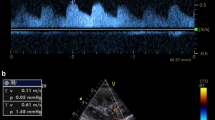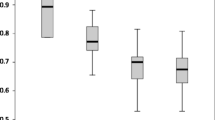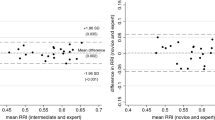Abstract
Background
This study aimed to assess observer variability and describe renal resistive index (RRI) and pulsatility index (PI) before and after onset of continuous kidney replacement therapy (CKRT). A secondary objective was to correlate Doppler ultrasound findings with those from direct measurement of renal blood flow (RBF).
Methods
This is a prospective observational study in hemodynamically stable Maryland piglets with and without acute kidney injury (AKI) and in hemodynamically unstable critically ill children requiring CKRT. Doppler-based RRI and PI were assessed for each subject. Measurements were made by two different operators (pediatric intensivists) before and after CKRT onset.
Results
Observer variability assessment in the measurement of RRI and PI rendered a moderate correlation for both RRI (ICC 0.65, IQR 0.51–0.76) and PI (ICC 0.63, IQR 0.47–0.75). RRI and PI showed no correlation with RBF or urine output. Baseline RRI and PI were normal in control piglets [RRI 0.68 (SD 0.02), PI 1.25 (SD 0.09)] and those with AKI [RRI 0.68 (SD 0.03), PI 1.20 (SD 0.13)]. Baseline RRI and PI were elevated in critically ill children (RRI 0.85, PI 2.0). PI and RRI did not change with CKRT in any study group.
Conclusions
Observer variability between inexperienced pediatric intensivists was comparable with that between senior and junior operators. Doppler-based calculations did not correlate with invasive measurements of RBF. RRI and PI were normal in hemodynamically stable piglets with and without AKI. RRI and PI were high in hemodynamically unstable patients requiring CKRT. RRI and PI did not change after CKRT onset, despite changes in hemodynamic status.
Graphical abstract
A higher resolution version of the Graphical abstract is available as Supplementary information







Similar content being viewed by others
References
Schnell D, Reynaud M, Venot M, Le Maho AL, Dinic M, Baulieu M, Ducos G, Terreaux J, Zeni F, Azoulay E, Meziani F, Duranteau J, Darmon M (2009) Resistive Index or color-Doppler semi-quantitative evaluation of renal perfusion by inexperienced physicians: results of a pilot study. Minerva Anestesiol 80:1273–1281
Schnell D, Darmon M (2015) Bedside Doppler ultrasound for the assessment of renal perfusion in the ICU: advantages and limitations of the available techniques. Crit Ultrasound J 7:24. https://doi.org/10.1186/s13089-015-0024-6
Schnell D, Darmon M (2012) Renal Doppler to assess renal perfusion in the critically ill: a reappraisal. Intensive Care Med 38:1751–1760
Deruddre S, Cheisson G, Mazoit J-X, Vicaut E, Benhamou D, Duranteau J (2007) Renal arterial resistance in septic shock: effects of increasing mean arterial pressure with norepinephrine on the renal resistive index assessed with Doppler ultrasonography. Intensive Care Med 33:1557–1562
Duranteau J, Deruddre S, Vigue B, Chemla D (2008) Doppler monitoring of renal hemodynamics: why the best is yet to come. Intensive Care Med 34:1360–1361
Lerolle N, Guérot E, Faisy C, Bornstain C, Diehl J-L, Fagon J-Y (2006) Renal failure in septic shock: predictive value of Doppler-based renal arterial resistive index. Intensive Care Med 32:1553–1559
Darmon M, Schortgen F, Vargas F, Liazydi A, Schlemmer B, Brun-Buisson C et al (2011) Diagnostic accuracy of Doppler renal resistive index for reversibility of acute kidney injury in critically ill patients. Intensive Care Med 37:68–76
Stevens PE, Gwyther SJ, Hanson ME, Boultbee JE, Kox WJ, Phillips ME (2009) Noninvasive monitoring of renal blood flow characteristics during acute renal failure in man. Intensive Care Med 16:153–158
Izumi M, Sugiura T, Nakamura H, Nagatoya K, Imai E, Hori M (2000) Differential diagnosis of prerenal azotemia from acute tubular necrosis and prediction of recovery by Doppler ultrasound. Am J Kidney Dis 35:713–719
Fernández SN, Santiago MJ, González R, López J, Solana MJ, Urbano J et al (2020) Changes in hemodynamics, renal blood flow and urine output during continuous renal replacement therapies. Sci Rep 10:20797
Santiago MJ, Fernández SN, Lázaro A, González R, Urbano J, López J et al (2016) Cisplatin-induced non-oliguric acute kidney injury in a pediatric experimental animal model in piglets. PLoS One 11:e0149013
Fernández Lafever SN, López J, González R, Solana MJ, Urbano J, López-Herce J, Butragueño L, Santiago MJ (2021) Hemodynamic disturbances and oliguria during continuous kidney replacement therapy in critically ill children. Pediatr Nephrol. https://doi.org/10.1007/s00467-020-04804-z
Tublin ME, Bude RO, Platt JF (2003) The resistive index in renal Doppler sonography: where do we stand? AJR Am J Roentgenol 180:885–892
Tublin ME, Tessler FN, Murphy ME (1999) Correlation between renal vascular resistance, pulse pressure, and the resistive index in isolated perfused rabbit kidneys. Radiology 213:258–264
Bude RO, Rubin JM (1999) Relationship between the resistive index and vascular compliance and resistance. Radiology 211:411–417
Ikee R, Kobayashi S, Hemmi N, Imakiire T, Kikuchi Y, Moriya H et al (2005) Correlation between the resistive index by Doppler ultrasound and kidney function and histology. Am J Kidney Dis 46:603–609
Cauwenberghs N, Kuznetsova T (2016) Determinants and prognostic significance of the renal resistive index. Pulse 3:172–178
Kuznetsova T, Cauwenberghs N, Knez J, Thijs L, Liu Y-P, Gu Y-M et al (2015) Doppler indexes of left ventricular systolic and diastolic flow and central pulse pressure in relation to renal resistive index. Am J Hypertens 28:535–545
Poston JT, Koyner JL (2019) Sepsis associated acute kidney injury. BMJ 364:k4891. https://doi.org/10.1136/bmj.k4891
Wan L, Yang N, Hiew C-Y, Schelleman A, Johnson L, May C et al (2008) An assessment of the accuracy of renal blood flow estimation by Doppler ultrasound. Intensive Care Med 34:1503–1510
Popović ZB, Thomas JD (2017) Assessing observer variability: a user’s guide. Cardiovasc Diagn Ther 7:317–324
London NJ, Aldoori MI, Lodge VG, Bates JA, Irving HC, Giles GR (1993) Reproducibility of Doppler ultrasound measurement of resistance index in renal allografts. Br J Radiol 66:510–513. https://doi.org/10.1259/0007-1285-66-786-510
Mikkonen RHM, Kreula JM, Virkkunen PJ (1996) Reproducibility of Doppler ultrasound measurements. Acta Radiol 37:545–550
Platt JF, Rubin JM, Ellis JH (1991) Acute renal failure: possible role of duplex Doppler US in distinction between acute prerenal failure and acute tubular necrosis. Radiology 179:419–423
Bossard G, Bourgoin P, Corbeau JJ, Huntzinger J, Beydon L (2011) Early detection of postoperative acute kidney injury by Doppler renal resistive index in cardiac surgery with cardiopulmonary bypass. Br J Anaesth 107:891–898
Bude RO, DiPietro MA, Platt JF, Rubin JM, Miesowicz S, Lundquist C (1992) Age dependency of the renal resistive index in healthy children. Radiology 184:469–473
Murat A, Akarsu S, Ozdemir H, Yildirim H, Kalender O (2005) Renal resistive index in healthy children. Eur J Radiol 53:67–71. https://doi.org/10.1016/j.ejrad.2004.05.005
Lauschke A, Teichgräber UKM, Frei U, Eckardt K-U (2006) “Low-dose” dopamine worsens renal perfusion in patients with acute renal failure. Kidney Int 69:1669–1674
Zhang H, Zhou K, Wang D, Zhang N, Liu J (2020) The predictive value of the intraoperative renal pulsatility Index for acute kidney injury in patients undergoing cardiac surgery. Minerva Anestesiol 86:1161–1169. https://doi.org/10.23736/S0375-9393.20.14460-2
Acknowledgements
We thank all the staff of the PICU and the Experimental Department of the Gregorio Marañón Hospital for their contribution and hard work. This study was supported by the Spanish Research Projects in Health funded by Carlos III Institute of health (ISCIII)—the state plan for scientific and technical research and innovation 2013–2016 and European Regional Development Fund (ERDF). Grant reference number PI17/00248. The authors were funded by the Research Network: RETICS “Maternal and Child Health and Development Network” (SAMID Network), funded by the PN I+D+i 2013–2016 (Spain), ISCIII-Sub-Directorate General for Research Assessment and Promotion and the European Regional Development Fund (ERDF), ref. RD16/0022/0007.
Author information
Authors and Affiliations
Corresponding author
Ethics declarations
Conflict of interest
The authors declare no competing interests.
Additional information
Publisher's Note
Springer Nature remains neutral with regard to jurisdictional claims in published maps and institutional affiliations.
Supplementary Information
Rights and permissions
About this article
Cite this article
Fernández, S.N., López, J., González, R. et al. Doppler ultrasound in the assessment of renal perfusion before and during continuous kidney replacement therapy in the pediatric intensive care unit. Pediatr Nephrol 37, 3205–3213 (2022). https://doi.org/10.1007/s00467-022-05428-1
Received:
Revised:
Accepted:
Published:
Issue Date:
DOI: https://doi.org/10.1007/s00467-022-05428-1




